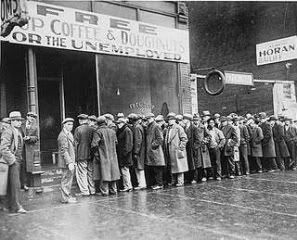crossposted at ProgressiveBlue
 The March Jobs Report has come, and though there appears to have been some employment growth in the rose colored glasses retailing sector, in most other sectors, the headline is that the Job Free Recovery continues.
The March Jobs Report has come, and though there appears to have been some employment growth in the rose colored glasses retailing sector, in most other sectors, the headline is that the Job Free Recovery continues.There are three main numbers to focus on when looking at the monthly employment report:
- employment
- the headline unemployment rate, seasonally adjusted
- the broad ("U6") unemployment rate, seasonally adjusted
... so let's have a look at them.
________________________
The report employment figure showed employment growth of 162,000. Is that good news? Bad news?
Well, its news to the extent that "the normal average season growth in employment" means that the string of job losses have come to an end. The headline unemployment rate was unchanged at 9.7%, while the broad unemployment rate increased from 16.8% to 16.9%, both seasonally adjusted.
When trying to work out what's going on with the business cycle, we look at seasonally adjusted figures, and that is, part of why the headline unemployment rate is constant. The raw figure is down by 0.2% ... but that's on average what is normal in moving from February to March.
The uptick in the seasonally adjusted broad unemployment rate is explained directly in the summary:
The number of persons working part time for economic reasons (sometimes referred to as involuntary part-time workers) increased to 9.1 million in March. These individuals were working part time because their hours had been cut back or because they were unable to find a full-time job. (See table A-8.)
So while employment increased, some of that was part-time work held by people who want full time work. Just as we would expect this early in a recovery, many businesses do not feel that they have to hire people full time when there is a wide choice of perfectly good workers who can be had with no commitment on their part.
How long would it take to get to full employment at this rate?
I saw someone "tweet" that at this rate, it would take a year to get the unemployment rate down by 1%. However, actually, since this increase in employment is very close to the seasonally expected increase, employment could grow "like this" for years without bringing the unemployment rate down by 1%.
"Like this" would, after all, be increases in employment in months where that's normal, and reductions in employment in months where that's normal.
This is why we need a Brawny Recovery: a recovery where we roll up our sleeves and get down to the work of catching up on thirty years of postponed investment in infrastructure, and thirty years of postponed establishment of a New Energy Economy to address the fact that we have an oil-addicted economy.
And there is no way to describe it other than oil addiction. After all, we are still a major oil producer. We produce about twice the world average, per person. However, we consume five times the world average.
Something to demand immediately
Something that can and should be done immediately is for the Federal Government to make up transit system budgets that are directly due to reductions in state and local sales tax receipts.
Of course, this needs to be in proportion to the downturn in tax receipts for given tax rates. We have to avoid setting up a system that encourages and rewards state and local governments that treat a budget crisis as an opportunity to throw the bus under a bus ... as in California, where the Governor seems determined to kill off public transport as a favor to his big oil contributors.
However, it should be backdated. This is something we should have been doing since September 2008, at the latest ... it is, indeed, something we should do for any recession. During a recession, farebox revenues decline, because people that have lost their job no longer have their daily commute. But the cost of operating the services remain fairly stable, and the need to have access to the services often increases. When at the same time dedicated or general fund tax receipts at the state and local level decline due to the recession, transport and transit authorities get hit with a double whammy.
There are lots of things that are a rightful part of a Brawny Recovery: electrification of local public transport corridors, establishment of Electricity Superhighways, establishment of a nationwide electric freight rail system, investment in energy efficiency upgrades to both public and private buildings ...
... but one that can have very rapid impacts is helping local transport cope with the fact that this recovery, like the two before it, look like it will take about a year before genuine employment growth starts to show up.
Not only will this help keep people in useful employment, but it will also ensure that the most vulnerable are not locked out of participating with the real employment growth, when it really does start to appear.


No comments:
Post a Comment